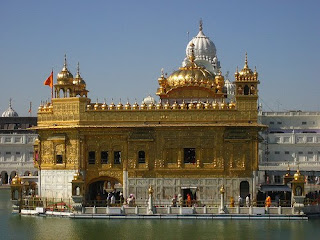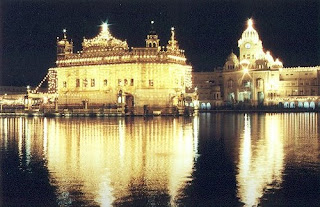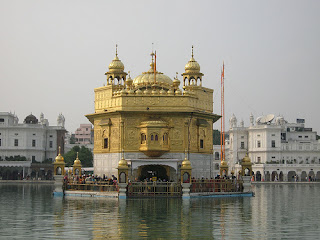Amritsar is a city in the northern part of India and is the administrative headquarters of Amritsar district in the state of Punjab, India. The 2001 Indian census reported the population of the city to be over 1,500,000, with that of the entire district numbering 3,695,077. Amritsar is situated 217 kilometres (135 mi) northwest of state capital Chandigarh and is 32 kilometres (20 mi) east of Lahore, Pakistan and therefore, very close to India's western border with Pakistan.
It is home to the Harmandir Sahib, known as the Golden Temple/Darbar Sahib, the spiritual and cultural center of the Sikh religion. This important Sikh shrine attracts more visitors than the Taj Mahal in Agra as it has more than 100,000 visitors on week days alone and is the number one destination for non-resident-Indians (NRI) in the whole of India.The city boasts of being the main centre of Sikhs' cultural, religious and political history. Amritsar is also known for the incidents of Jallianwala Bagh Massacre in 1919 under British Rule and Operation Bluestar in 1984 under the late Prime Minister of India, Indira Gandhi. The main commercial activities include tourism, carpets and fabrics, farm produce, handicrafts, service trades and light engineering. The city is known for its food and culture. Amritsar is also home to Central Khalsa Orphanage, which was once a home for Shaheed Udham Singh, a prominent figure in the Indian independence movement.
It is home to the Harmandir Sahib, known as the Golden Temple/Darbar Sahib, the spiritual and cultural center of the Sikh religion. This important Sikh shrine attracts more visitors than the Taj Mahal in Agra as it has more than 100,000 visitors on week days alone and is the number one destination for non-resident-Indians (NRI) in the whole of India.The city boasts of being the main centre of Sikhs' cultural, religious and political history. Amritsar is also known for the incidents of Jallianwala Bagh Massacre in 1919 under British Rule and Operation Bluestar in 1984 under the late Prime Minister of India, Indira Gandhi. The main commercial activities include tourism, carpets and fabrics, farm produce, handicrafts, service trades and light engineering. The city is known for its food and culture. Amritsar is also home to Central Khalsa Orphanage, which was once a home for Shaheed Udham Singh, a prominent figure in the Indian independence movement.
How to Reach Amritsar
By Air:
Amritsar's international airport, Sri Guru Ram Dass Jee International Airport, has more than 200 domestic and international flights during the week with daily connections to Delhi, Chandigarh and Jammu in India and international flights to Tehraan, Frankfurt (Mahan Air), Doha Qatar Airways,Ashgabat Turkmenistan Airlines,Tashkent Uzbekistan Airways.By Rail:
Amritsar is well connected with daily trains from Delhi, Mumbai, Kolkata, Chennai, Hyderabad, Thiruvananthapuram, Indore, Bhopal, Agra, Gwalior, Jabalpur, Ujjain, Ahmedabad, Pune, Chandigarh and other major Indian cities. Amritsar Railway Station is the main terminal station. There is a special train that runs west to Wagah (Attari Border), which is the last station on the border in India before continuing on to Pakistan.Indian Railways has proposed a high speed rail line to serve Delhi-Amritsar via Chandigarh and Ambala. The train is to run at high speeds of 350 km/h, second only in India to the Bhopal Shatabdi Express. It will travel the 445 km between the two cities in 2.5 hours (compared to the current time of 5 hours). Companies from Japan, China, UK and Canada have expressed an interest in the project. The contract for building the line were to be awarded at the end of May 2008. Other lines of this kind have proposed in Mumbai, Ahmedabad, Pune, and Kolkata.
By Road:
Amritsar is located on the historic Grand Trunk Road (G.T Road), also known as National Highway 1, and therefore very well connected to the road network. Daily bus services run to and from Ambala, Delhi, Chandigarh and Jammu. Rs 450 crores is being spent to expand the Amritsar-Jalandhar stretch of G.T. Road to four lanes. In 2010, elevated road with four lanes connected to the National highway for better access to the Golden Temple has been started.For transportation within Amritsar city, rickshaws, auto rickshaws, taxis and buses are easily available. Recently, the government of India and Punjab pledged Rs. 2,100 crore for the development of a mass rapid transport system for the city.[citation needed] It is hoped that this will help relieve traffic congestion and improve air quality.
Places to Visit in Amritsar
Harmandir Sahib - Golden Temple
The Harmandir Sahib also Darbar Sahib, also referred to as the Golden Temple, is a prominent Sikh gurdwara located in the city of Amritsar, Punjab (India). Construction of the gurdwara was begun by Guru Ram Das, the fourth Sikh Guru, and completed by his successor, Guru Arjan Dev. In 1604, Guru Arjan Dev completed the Adi Granth, the holy scripture of Sikhism, and installed it in the Gurdwara. In 1634, Guru Hargobind left Amritsar for the Shivalik Hills and for the remainder of the seventeenth century the city and gurdwara was in the hands of forces hostile to the Sikh Gurus. During the eighteenth century, the Harmandir Sahib was the site of frequent fighting between the Sikhs on one side and either Mughal or Afghan forces on the other side and the gurdwara occasionally suffered damage. In the early nineteenth century, Maharaja Ranjit Singh secured the Punjab region from outside attack and covered the upper floors of the gurdwara with gold, which gives it its distinctive appearance and English name of "Golden Temple".
Located in Amritsar, Harmandir Sahib is considered holy by Sikhs because the eternal guru of Sikhism, the Sri Guru Granth Sahib, is always present inside it and its construction was mainly intended to build a place of worship for men and women from all walks of life and all religion to come and worship God equally. The Sri Guru Granth Sahib is the holiest literature in the Sikh religion, the tenth guru of Sikhism, Guru Gobind Singh, in 1708 at Nanded made it the eternal Sikh Guru and the leader of Sikhism. Anywhere in the world where the Guru Granth Sahib is present is equally holy and precious to Sikhs.
Its name literally means Temple of God. The fourth guru of Sikhism, Guru Ram Das, excavated a tank in 1577 CE which subsequently became known as Amritsar (meaning "Pool of the Nectar of Immortality"), giving its name to the city that grew around it. In due course, a splendid Sikh edifice, Harmandir Sahib (meaning "the abode of God"), rose in the middle of this tank and became the supreme centre of Sikhism. Its sanctum came to house the Adi Granth comprising compositions of Sikh gurus and other saints considered to have Sikh values and philosophies, e.g., Baba Farid, and Kabir. The compilation of the Adi Granth was started by the fifth guru of Sikhism, Guru Arjan Dev.
Jallianwala Bagh
Jallianwala Bagh is a public garden in Amritsar in the Punjab province of India, and houses a memorial of national importance, established in 1951 to commemorate the murder of peaceful celebrators on the occasion of the Punjabi New Year on April 13, 1919 in the Jallianwala Bagh Massacre. Official British Raj sources placed the fatalities at 379, and with 1100 wounded. Civil Surgeon Dr. Smith indicated that there were 1,526 casualties. The true figures of fatalities are unknown, but are likely to be higher than the official figure of 379.
The 6.5-acre (26,000 m2) garden site of the massacre is located in the vicinity of Golden Temple complex, the holiest shrine of Sikhism.
The memorial is managed by the Jallianwala Bagh National Memorial Trust, which was established as per the Jallianwala Bagh National Memorial Act passed by the Government of India in 1951.
Wagah Border
Wagah is the only road border crossing between India and Pakistan, and lies on the Grand Trunk Road between the cities of Amritsar, India and Lahore, Pakistan. Wagah itself is a village through which the controversial Radcliffe Line was drawn. The village was divided by independence in 1947. Today, the eastern half of the village remains in the Republic of India while the western half is in Pakistan.
The Wagah border, often called the "Berlin wall of Asia", is a ceremonial border on the India–Pakistan Border where each evening there is a retreat ceremony called 'lowering of the flags', which has been held since 1959. At that time there is an energetic parade by the Border Security Force (B.S.F) of India and the Pakistan Rangers soldiers. It may appear slightly aggressive and even hostile to foreigners but in fact the paraders are imitating the pride and anger of a Cockerel. Troops of each country put on a show in their uniforms with their colorful turbans. Border officials from the two countries sometimes walk over to the offices on the other side for day to day affairs. The happenings at this border post have been a barometer of the India-Pakistan relations over the years.
Samjhauta Express, the train service between Lahore and Delhi, plies twice a week from Attari railway station, 5 km from Wagah. The National Highway of India starts from Wagah Border, and is the transit point for the Delhi–Lahore Bus service operating within the Punjab between Amritsar and Lahore, which was started in 2004 as relations between the two countries improved.
Best Time to Visit Amritsar
Best time to visit Amritsar is in the winter, between October and March.










No comments:
Post a Comment